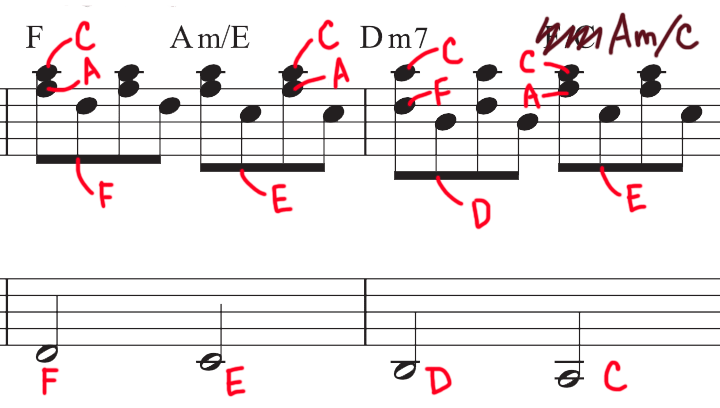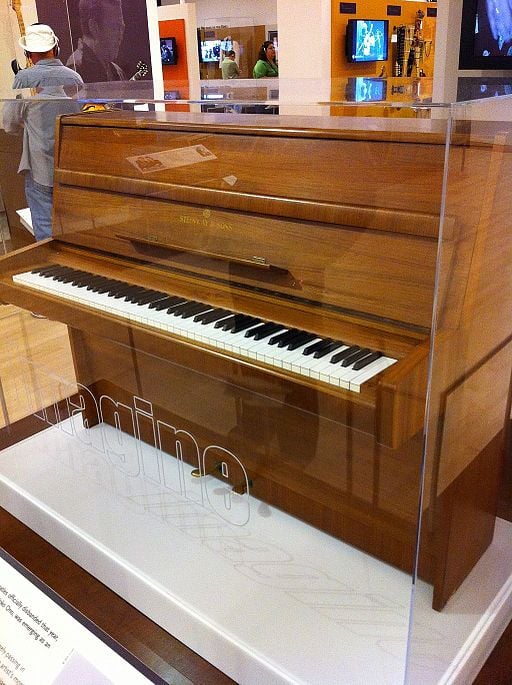Want to learn “Imagine” by John Lennon on piano? Good choice! If you’re learning how to play piano, this is a lovely piece that’s both friendly to beginners and challenging enough to be rewarding. It’s in C Major, so you don’t have to worry about sharps and flats. It also sounds authentic at a slow tempo. Last but not least, it’s an iconic ballad written by one of pop music’s finest songwriters.
This tutorial will cover the following sections of “Imagine”:
Love our video tutorial? Your favorite song might be next! Subscribe to our newsletter for piano news, exclusive interviews, new tutorials, interesting articles, and more delivered to your inbox every week. Unsubscribe at any time.
We open “Imagine” with its iconic riff. This riff is the backbone of the verse section.
On your left hand, play C and F two octaves below middle C. These notes act as anchor notes. Your right hand will play in the octave one below middle C. We’ve written out these notes in the bass clef to make them easier to visualize.
You may notice that in the first measure, we’re essentially playing a C Major triad (C-E-G). But we alternate between the top two notes (E and G) and the root note, C.
Then, we move to an F chord. On our left hand, we’ll play the bass note, F. On our right hand, we’ll oscillate between F-A and C.
Finally, we round off the riff with a chromatic climb: A – Bb – B.
In the pre-chorus section, we keep using the same rocking motion, but the chords get a little more complex. Here’s the progression:
F – Am/E – Dm7 – Am/C – G – G
If this looks scary and complicated, don’t worry! For starters, you already know the F chord. It’s just played slightly differently in the right hand. The top notes are A-C and the bottom note is F.
Let’s take a look at the Am/E, Dm7 and Am/C chords.
Am/E and Am/C are slash chords. A slash chord is when you play the chord before the slash on your right hand and the note after the slash on your left hand.
For Am/E, this means we play E on our left hand and oscillate between A-C and E on our right hand.

“F/C” is actually a typo (oops!) — this chord should be Am/C. Which means we play C with our left hand and rock between A-C and E on our right.
Now, what about the Dm7 chord in between? Dm7 is a seventh chord — a jazzy type of chord that contains the notes D-F-A-C. On your left hand, you’ll play D. On your right, you’ll alternate between F-C and D.
Then, close off the section with two G chords, one in second inversion and one in root position. That’s it!
You may notice that your left hand is playing a descending scale. Don’t be afraid to isolate this section and practice it slowly several times before moving along — the chord changes in this section are a little quicker so it may take some extra practice.
The chorus begins with a pretty simple F chord followed by a G chord. Just watch out that the right hand goes from F-A to A-C on the F chord.
The G chord is a basic G triad: G on the left hand, and alternating between B-D and G on the right.
Then, we move into a C Major chord and there’s a little turnaround at the end where we add a B. Give this bit some extra practice to smooth it out. Slow down the tempo if you need to.

This segues us nicely into an E Major chord. E Major contains the notes E-G#-B, so watch out for that G sharp!
What follows is an E7 chord. An E7 chord is E-G#-B-D. That extra D (the seventh note of the E Major scale) adds an extra touch of color to the song. It’s proof of John Lennon’s skill as a songwriter.
Then, this measure just repeats! Note the natural sign (♮) by the next G — this just means this G doesn’t get sharped.
That’s it! You’ve made it through all three sections of this revered song 🙂
And while it’s a slow and steady tune, the iconic moments — such as that chromatic climb — give it plenty of intrigue.
Practice lots to make this song sound tight, and you’ll build important life-long skills as a piano player.
Remember: there’s absolutely no shame in slowing things down! You can use a metronome, set it to a slow tempo, and then gradually crank up the speed.
If you struggle with some of the transitions, isolate those sections and practice them. Don’t just practice the song from beginning to end over and over. Being specific about what you practice is more efficient and effective.
You can also use a recording of the track as a reference. It’ll help your ear training, and the more you know a song, the easier it will be to practice.

Finally, you can watch a video of me (Jordan) playing this song in full here. And remember, just because a song sounds simple doesn’t mean there isn’t a lot to learn. Happy practicing!
As a Pianote+ Member, you’ll get access to our 10-step Method, 1000+ song library, real teachers, world-class Coaches, and a growing community of piano players just like you.
Jordan Leibel is passionate about songwriting, improvisation, and helping you become a creative musician! He’s worked as a composer for film, commercial, and theatre projects as well as a session musician and producer for recording work.
/marketing/pianote/promos/april/banner-bg-m.webp)
We use cookies for traffic data and advertising. Cookie Policy »
/marketing/pianote/promos/april/banner-title.webp)